Monique Snyman's Blog
June 13, 2025
Hall of Horror: The Dancing Plague of 1518
In the sweltering summer of 1518, something bizarre unfolded on the cobbled streets of Strasbourg. A woman stepped into the town square and started to dance. Not a joyful jig or drunken twirl. No, this was compulsive, relentless movement. There was no music, no festival or celebration. She just danced. Then, another person joined. Then another. Within a week, dozens of people were dancing until they collapsed. By the end of the month, hundreds were swept up in a frenzy that would leave many dead, others broken, and everyone else asking: What just happened?
The Dancing Plague of 1518 isn���t a myth or a twisted folktale. It���s a documented event so strange that even modern scholars struggle to explain it. And the creepiest part? It wasn���t the only time this happened.
Table of Contents
ToggleThe Dancing Plague of 1518The Madness Takes HoldTheories That Make It WorseWe���re Not As Safe As We Think
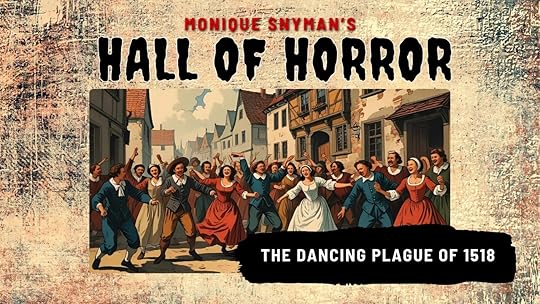
It all started with Frau Troffea, who danced for six days straight, and people began to gather, gawking at her strange ritual. But curiosity quickly gave way to confusion and fear when others began to mimic her, unable to stop. The number grew from one to dozens, and then to more than four hundred people. Local officials, in an attempt to help, made things worse by setting up stages and hiring musicians. Maybe, they thought, the dancers just needed to exhaust the urge out of their systems.
What followed was horrifying. People danced until their feet bled. They screamed in pain while their bodies kept moving. Many collapsed from sheer exhaustion. Some died from strokes, heart attacks, or dehydration. The city descended into chaos. Doctors were baffled. Priests warned of divine punishment. And no one ��� not the clergy, not the physicians, not the victims ��� could stop the dance.
Theories That Make It WorseYou���d think, after 500 years, we���d have a clear answer. Nope. What we have are theories, and each one is more disturbing than the last.
One popular explanation is ergot poisoning, which is a hallucinogenic mold that grows on damp rye and can cause convulsions, delusions, and even death ��� also used to explain the Salem Witch Trials. Sounds plausible until you remember these people didn���t just twitch or shake. They danced in rhythm. For quite some time, and they did it in the heat of summer, when ergot contamination would���ve been unlikely.
Another theory? Mass hysteria. The psychological kind. Strasbourg in 1518 was riddled with famine, disease, political unrest, and a deeply religious population who feared the wrath of saints. Under this pressure cooker, some historians believe the townspeople simply broke. Not individually, but collectively. Their minds short-circuited, and their bodies followed.
But mass hysteria doesn���t quite explain the physical toll. These weren���t mere trances. Some dancers were reportedly fully conscious, terrified by what was happening to their bodies. They didn���t want to dance. They simply couldn���t stop.
Other theories are more supernatural in nature, citing divine punishment, possession, or even secret cults as the cause.
The truth is, we can’t say it was or wasn’t any of the abovementioned things … Was it a physical illness or a psychological contagion? A cultural trauma response? A town-wide breakdown? Or something else entirely?
We���re Not As Safe As We ThinkIt���s easy to write off the dancing plague as an odd historical footnote, a freak event from a time when people bled each other with leeches and thought comets were omens. But here���s the part that will send a shiver down your spine: we���re not immune to mass psychogenic illness. We���ve seen it since then, even if it���s not in the same theatrical, bone-snapping form.
In 1962, a laughter epidemic broke out in Tanzania. Schoolgirls couldn���t stop giggling, and soon the laughter spread like wildfire. In the 1980s, dozens of schoolchildren in the West Bank fainted for no clear reason. In modern workplaces, cases of fainting, nausea, and strange tics have swept through entire office floors with no biological cause.
And then there���s the internet. Digital spaces can now transmit collective delusion and fear faster than any airborne virus. One person���s TikTok tic becomes a wave of neurological mimicry. An unexplained symptom turns into a full-blown community of sufferers. We���re still susceptible because our wiring hasn���t changed, just the platform.
The Dancing Plague reminds us how thin the line is between control and chaos. How powerful suggestion, fear, and trauma can be, not to mention how sometimes, the scariest thing isn���t what���s haunting us from the shadows, but rather what���s happening in plain sight, in full daylight, with our own bodies leading the rebellion.
So no, we still don���t know why the people of Strasbourg danced themselves to death. But maybe that���s the point. Maybe what makes this story stick is that unsettling lack of closure, that gaping hole where answers should be. A mystery that twitches at the edge of our modern minds and whispers: it could happen again.
And if it does, don���t say you weren���t warned.
If you liked this instalment of��Monique Snyman���s Hall of Horror, make sure to��subscribe to her newsletter��so you don���t miss a single post!
June 5, 2025
Meet the Kasa-Obake, Japan���s Forgotten Folklore Freak
You ever feel like your junk might come to life and come for revenge? No? Then you haven���t met the Kasa-Obake.
At first glance, the Kasa-Obake looks like a joke: a haunted umbrella with one leg, one bulging eye, and a tongue that hangs from its toothless mouth like it���s mocking you. But don���t be fooled. This freaky little yokai isn���t just a gag in a haunted house ��� it���s a centuries-old supernatural entity born from Japan���s belief that even the inanimate can grow a soul.
And when they do? They don���t always come in peace.
Table of Contents
ToggleHaunted Housewares and the Rise of the TsukumogamiIt���s All Fun and Games Until the Tongue Hits YouWhy the Kasa-Obake Belongs in Modern HorrorSo, Treat Your Stuff Right Or Else …
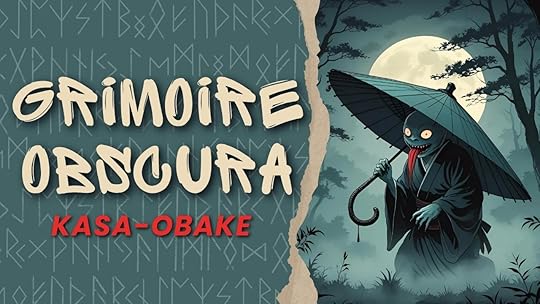
The Kasa-Obake is part of a broader category of yokai called tsukumogami, which is basically everyday household items that come to life after existing for 100 years. Let that sink in. Your old toaster? Your beat-up sneakers? That creepy porcelain doll your grandma gave you and you shoved in a closet? In Japanese folklore, they���re all potential spirits-in-waiting.
But the Kasa-Obake is the poster child of this tradition. Thought to be a once-beloved paper umbrella forgotten in a corner, neglected until time and resentment gave it life, it emerges one night on one leg ��� hopping, wheezing, flailing ��� ready to remind you that it was never just an umbrella.
Some stories say it plays pranks. Others say it waits until you���re alone, then appears at your side with a wet plop, eye twitching, tongue flicking, waiting to see how long it takes you to scream.
It���s equal parts pathetic and disturbing, exactly what makes it unforgettable.
It���s All Fun and Games Until the Tongue Hits YouThe Kasa-Obake walks the line between comic relief and cursed entity, but it���s that ambiguity that makes it so unsettling. One minute it’s bouncing around, being goofy, the next it’s licking the back of your neck in the dark and vanishing before you can turn around.
Some versions of the legend paint it as harmless, even helpful. Others aren���t so kind. One story claims it visits bad children at night. Another says it waits in rain-soaked alleyways to stalk the lonely. Because what better way to prey on people than to look completely ridiculous? No one���s afraid of an umbrella … until it blinks at you.
Why the Kasa-Obake Belongs in Modern HorrorYou want original? You want offbeat? You want nightmare fuel disguised as nonsense? The Kasa-Obake delivers.
In a horror landscape bloated with copy-paste monsters, this yokai offers the perfect blend of absurdity and existential dread. It taps into something subtle and uncanny: the idea that the things we discard, forget, or abuse … remember. That the familiar can turn foreign. That something innocent, like the umbrella by your door, might open itself one night, and watch you back.
Visually, it���s surreal. Tonally, it���s disorienting. Psychologically? It hits that sweet spot between fear and fascination. And in an era where haunted dolls and possessed houses have saturated the genre, a haunted umbrella that hops, licks, and watches? That���s the kind of monster horror needs more of, in my opinion.
So, Treat Your Stuff Right Or Else …The Kasa-Obake might look like a punchline, but its roots are ancient, and its message is clear: nothing stays forgotten forever. Whether it comes back to prank you, haunt you, or just creep you the hell out, one thing���s for sure, you���ll never look at old junk the same way again.
So next time you see that one-eyed, one-legged umbrella in your dream, ask yourself: What have you been neglecting lately?
Want another freaky folkloric deep-dive next Friday? We���re just getting started. Check out other entries in the Grimoire Obscura����� because basic monsters are so last season.
June 3, 2025
These 7 Cozy-ish Horror Novels Bring Chills Just in Time for Summer
It���s summer in the Northern Hemisphere! Yes, it’s all sun, sand, and fun ��� and something is definitely scratching behind the wall. Forget everything you think you know about horror, friends. Cozy horror isn���t about slashing through the woods or hiding from masked maniacs ��� it���s the kind of creepy that tiptoes in during daylight. It���s teacups rattling on their saucers, a shadow passing just outside the window, a ghost politely asking if you���d like more sugar.
Now, are all of these books strictly cozy horror? Not quite. But they���re definitely cozy-adjacent. Think of them as horror���s softer, weirder siblings ��� strange little stories that know how to simmer instead of scream. They���re unsettling in a way that lingers, like the scent of lilacs with something sour underneath. You���ll laugh, you���ll shiver, and you���ll probably question that noise in the hallway.
These seven cozy-ish horror novels are sharp, emotionally layered, and totally unique, just like your favorite thrifted sweater. The vibes are strong, the frights are subtle (mostly), and the ghosts have excellent manners.
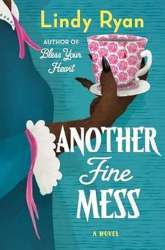 Another Fine Mess by Lindy Ryan
Another Fine Mess by Lindy Ryan
This book is all charm and chaos. Ghosts, trauma, and found family all converge in a story that feels like walking into a haunted antique shop run by witches who swear a lot. With vivid characters and just the right amount of spectral sass, Another Fine Mess is your new springtime obsession. It���s warm, weird, and wrapped in a haunted hug of healing. The spooky atmosphere blends with moments of humor, making it feel like an unsettling but strangely comfortable place to be.
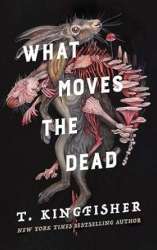 What Moves the Dead by T. Kingfisher
What Moves the Dead by T. Kingfisher
A retelling of Poe���s The Fall of the House of Usher, but with mushrooms, unsettling hares, and one very sarcastic ex-soldier. It���s gorgeously weird, with gothic decay oozing through every page. But the dry humor and bizarre beauty make it feel like horror with a vintage twist. If fungi-core was a genre, this would be its crowned queen. Kingfisher���s writing invites you into a world where the grotesque becomes strangely beautiful, and the tension is laced with dark humor.
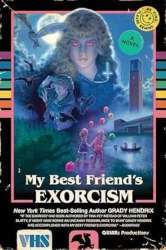 My Best Friend���s Exorcism by Grady Hendrix
My Best Friend���s Exorcism by Grady Hendrix
Think The Babysitter���s Club meets The Exorcist. It���s all ���80s nostalgia, high school drama, and one unforgettable demonic possession. This one balances friendship, fear, and neon-colored angst with a flair that makes it oddly comforting if you���re the kind of person who finds comfort in exorcisms. Beneath the horror, it���s a love letter to messy girlhood and ride-or-die loyalty. It���s both unsettling and strangely heartwarming, making you remember that true friendship always fights back against the darkness.
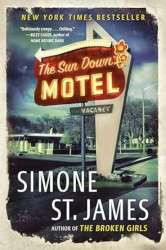 The Sun Down Motel by Simone St. James
The Sun Down Motel by Simone St. James
Split between past and present timelines, this mystery-horror hybrid oozes with atmosphere. A haunted roadside motel, missing girls, and a whole lot of small-town secrets. Creepy, yes, but with a strong emotional core and fierce female leads, it���s horror that hugs back. It reads like Nancy Drew wandered into a Stephen King town and refused to flinch. The characters’ unwavering determination to uncover the truth in a place steeped in malevolent history will keep you hooked until the final page.
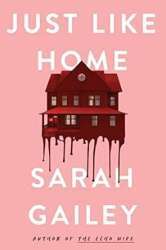 Just Like Home by Sarah Gailey
Just Like Home by Sarah Gailey
Home is where the horror is. Especially when your dad might have been a serial killer. Gailey weaves a slow, skin-crawling story of inheritance, identity, and the kind of domestic horror that sinks its claws into your psyche. It���s beautifully strange and deeply personal ��� a gothic tale wrapped in bloodstained bedsheets and memory. The story unfolds at a pace that lets you feel the horror settling into your bones, forcing you to ask: what is truly lurking within the walls of home?
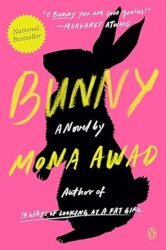 Bunny by Mona Awad
Bunny by Mona Awad
This book is unhinged in the most delightful way. Set at an elite MFA program, it���s about cult-like friendships, identity crises, and possibly��� bunnies that explode? It���s part horror, part satire, and entirely deranged. Reading it feels like drinking too much chamomile tea and realizing it���s laced with glitter and existential dread. Awad���s writing is a chaotic symphony, making you laugh nervously and then recoil at the odd, unpredictable turns it takes.
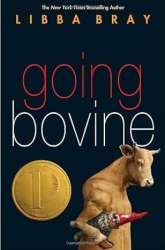 Going Bovine by Libba Bray
Going Bovine by Libba Bray
Is it horror? Is it a fever dream? Does it matter? A madcap road trip through a dying teenage boy���s delusions (or are they?), this book is absurd, hilarious, and deeply emotional. With Norse gods, talking lawn gnomes, and moments of existential dread, it���s weird in a way that feels like horror���s goofier, kinder cousin. It’s heartbreak in a Hawaiian shirt, and somehow, it works. Through all its eccentricities, it���s ultimately a poignant exploration of life, death, and the absurdity of it all.
Check out some other��Book Lists, and make sure to��subscribe to Monique���s newsletter��so you don���t miss a single post!
June 2, 2025
Kazuo Ishiguro���s ���Never Let Me Go��� Continues to Haunt Us 20 Years Later ���
Kazuo Ishiguro���s Never Let Me Go is a haunting unraveling of memory, loss, and the quiet horror of lives shaped by a system designed to keep people docile while their humanity is methodically stripped away. On the surface, it���s the story of Kathy H., a ���carer��� reflecting on her youth at an exclusive English boarding school. But the further in you read, the more the novel reveals that this isn���t a nostalgic coming-of-age tale, but rather an in-depth look at stolen lives dressed in soft-focus memories and gentle friendships that can���t outrun their fate.
Table of Contents
ToggleNever Let Me Go by Kazuo IshiguroThe Illusion of Childhood and the Things Left UnsaidWhat Makes Us Human Isn���t Always EnoughWhen Memory Becomes the Only Thing You Can KeepAbout Kazuo Ishiguro:Never Let Me Go by Kazuo IshiguroThis year marks the 20th anniversary of Never Let Me Go, and to celebrate, Penguin Random House���s Vintage imprint has reissued the novel in a stunning new edition. An excerpt is available to read on their website.
The Illusion of Childhood and the Things Left UnsaidHailsham is idyllic at first glance. The children there play games, create art, and attend poetry readings. They���re told their work might end up in a mysterious ���Gallery,��� which becomes a point of pride and mystery, but under all of it lies there���s a steady current of avoidance. The students are told just enough to accept their future as organ donors, but not enough to truly understand what it means.
As one guardian says, they���ve been ���told and not told.��� And that line? It stays with you.
The brilliance of the novel is how it captures the way indoctrination can feel ordinary when it���s all you���ve ever known. Kathy, Ruth, and Tommy don���t question the structure of their lives the way we, as readers, want them to. They navigate friendships, heartbreak, and longing with the same confusion and hope we all do, even as the edge of the cliff inches closer. It���s not dystopia in the traditional sense. It���s worse. It���s reality twisted just enough to feel plausible and heartbreakingly familiar.
What Makes Us Human Isn���t Always EnoughThe book���s central tension hinges on a simple, agonizing question: If you prove you have a soul, will someone care enough to save you?
That���s the unspoken hope behind Hailsham���s Gallery and the rumoured ���deferrals��� ��� a myth that love might buy you more time. When Kathy and Tommy finally confront Madame and Miss Emily, they learn the truth. The Gallery wasn���t about deferrals. It was about proving to a cold, pragmatic world that these children ��� these clones ��� were just as human as anyone else. That they deserved better, but the experiment failed. The world didn���t want to look too closely.
Never Let Me Go isn���t a book that offers redemption or rebellion. No one escapes. There���s no grand uprising. Just resignation. And somehow, that���s what makes it so devastating. Tommy���s breakdown outside the car after their visit to Madame is one of the rawest moments in the novel. Not because it���s loud or dramatic, but because it���s the first and only time we see pure, unfiltered rage at a system that never gave them a chance.
When Memory Becomes the Only Thing You Can KeepKathy���s narration is both intimate and emotionally distanced, which might seem contradictory until you realize it mirrors how she���s learned to survive. She clings to memories because they���re all she has left. Hailsham, for her, becomes a kind of sanctuary. A time before the donations began. Before Ruth ���completed.��� Before she had to watch Tommy die, piece by piece.
There���s something deeply unsettling about how calm it all is. Kathy���s voice is never bitter, never angry. She reflects on her life with a kind of quiet grace, even when recounting the worst of it. But make no mistake, there���s rage buried deep in these pages; it���s just been socialized into submission.
What Ishiguro accomplishes here is surgical. He writes a world where people are groomed to accept their fate and stripped of the language to fight back. The horror is in the normalcy. And the tragedy? It���s in how easy it is to imagine our own society making the same choices under the right circumstances.
Never Let Me Go doesn���t rely on twists or elaborate worldbuilding to land its blow. It���s quiet, precise, and all the more devastating for it. It asks hard questions about ethics, humanity, and what we choose to ignore when the truth gets uncomfortable, and it leaves you with the kind of ache that lingers.
About Kazuo Ishiguro: Photo: �� Andrew Testa
Photo: �� Andrew TestaKazuo Ishiguro was born in Nagasaki, Japan, in 1954 and moved to Britain at the age of five. His works of fiction have earned him many honours around the world, including the Nobel Prize in Literature and the Booker Prize. His books have been translated into over fifty languages and The Remains of the Day��and��Never Let Me Go��were both made into acclaimed films. He received a knighthood in 2018 for Services to Literature. He also holds the decorations of Chevalier de l���Ordre des Arts et des Lettres from France and the Order of the Rising Sun, Gold and Silver Star from Japan. His most recent novel,��Klara and the Sun��was a number one��Sunday Times��bestseller in both hardback and paperback.
Ishiguro also works occasionally as a screenwriter. His screenplay for the 2022 film��Living��received Academy Award (Oscar) and BAFTA nominations. Cinema adaptations of��Klara and the Sun��and��A Pale View of Hills are due for release in 2025.
Kazuo Ishiguro���s ���Never Let Me Go��� Continues to Haunt Us 20 Years Later ���
Kazuo Ishiguro���s Never Let Me Go is a haunting unraveling of memory, loss, and the quiet horror of lives shaped by a system designed to keep people docile while their humanity is methodically stripped away. On the surface, it���s the story of Kathy H., a ���carer��� reflecting on her youth at an exclusive English boarding school. But the further in you read, the more the novel reveals that this isn���t a nostalgic coming-of-age tale, but rather an in-depth look at stolen lives dressed in soft-focus memories and gentle friendships that can���t outrun their fate.
Table of Contents
ToggleNever Let Me Go by Kazuo IshiguroThe Illusion of Childhood and the Things Left UnsaidWhat Makes Us Human Isn���t Always EnoughWhen Memory Becomes the Only Thing You Can KeepAbout Kazuo Ishiguro:Never Let Me Go by Kazuo IshiguroThis year marks the 20th anniversary of Never Let Me Go, and to celebrate, Penguin Random House���s Vintage imprint has reissued the novel in a stunning new edition. An excerpt is available to read on their website.
The Illusion of Childhood and the Things Left UnsaidHailsham is idyllic at first glance. The children there play games, create art, and attend poetry readings. They���re told their work might end up in a mysterious ���Gallery,��� which becomes a point of pride and mystery, but under all of it lies there���s a steady current of avoidance. The students are told just enough to accept their future as organ donors, but not enough to truly understand what it means.
As one guardian says, they���ve been ���told and not told.��� And that line? It stays with you.
The brilliance of the novel is how it captures the way indoctrination can feel ordinary when it���s all you���ve ever known. Kathy, Ruth, and Tommy don���t question the structure of their lives the way we, as readers, want them to. They navigate friendships, heartbreak, and longing with the same confusion and hope we all do, even as the edge of the cliff inches closer. It���s not dystopia in the traditional sense. It���s worse. It���s reality twisted just enough to feel plausible and heartbreakingly familiar.
What Makes Us Human Isn���t Always EnoughThe book���s central tension hinges on a simple, agonizing question: If you prove you have a soul, will someone care enough to save you?
That���s the unspoken hope behind Hailsham���s Gallery and the rumoured ���deferrals��� ��� a myth that love might buy you more time. When Kathy and Tommy finally confront Madame and Miss Emily, they learn the truth. The Gallery wasn���t about deferrals. It was about proving to a cold, pragmatic world that these children ��� these clones ��� were just as human as anyone else. That they deserved better, but the experiment failed. The world didn���t want to look too closely.
Never Let Me Go isn���t a book that offers redemption or rebellion. No one escapes. There���s no grand uprising. Just resignation. And somehow, that���s what makes it so devastating. Tommy���s breakdown outside the car after their visit to Madame is one of the rawest moments in the novel. Not because it���s loud or dramatic, but because it���s the first and only time we see pure, unfiltered rage at a system that never gave them a chance.
When Memory Becomes the Only Thing You Can KeepKathy���s narration is both intimate and emotionally distanced, which might seem contradictory until you realize it mirrors how she���s learned to survive. She clings to memories because they���re all she has left. Hailsham, for her, becomes a kind of sanctuary. A time before the donations began. Before Ruth ���completed.��� Before she had to watch Tommy die, piece by piece.
There���s something deeply unsettling about how calm it all is. Kathy���s voice is never bitter, never angry. She reflects on her life with a kind of quiet grace, even when recounting the worst of it. But make no mistake, there���s rage buried deep in these pages; it���s just been socialized into submission.
What Ishiguro accomplishes here is surgical. He writes a world where people are groomed to accept their fate and stripped of the language to fight back. The horror is in the normalcy. And the tragedy? It���s in how easy it is to imagine our own society making the same choices under the right circumstances.
Never Let Me Go doesn���t rely on twists or elaborate worldbuilding to land its blow. It���s quiet, precise, and all the more devastating for it. It asks hard questions about ethics, humanity, and what we choose to ignore when the truth gets uncomfortable, and it leaves you with the kind of ache that lingers.
About Kazuo Ishiguro: Photo: �� Andrew Testa
Photo: �� Andrew TestaKazuo Ishiguro was born in Nagasaki, Japan, in 1954 and moved to Britain at the age of five. His works of fiction have earned him many honours around the world, including the Nobel Prize in Literature and the Booker Prize. His books have been translated into over fifty languages and The Remains of the Day��and��Never Let Me Go��were both made into acclaimed films. He received a knighthood in 2018 for Services to Literature. He also holds the decorations of Chevalier de l���Ordre des Arts et des Lettres from France and the Order of the Rising Sun, Gold and Silver Star from Japan. His most recent novel,��Klara and the Sun��was a number one��Sunday Times��bestseller in both hardback and paperback.
Ishiguro also works occasionally as a screenwriter. His screenplay for the 2022 film��Living��received Academy Award (Oscar) and BAFTA nominations. Cinema adaptations of��Klara and the Sun��and��A Pale View of Hills are due for release in 2025.
May 30, 2025
Hall of Horror: The Hinterkaifeck Murders
Welcome back to another edition of Monique Snyman’s Hall of Horror! This week, we’re covering the Hinterkaifeck Murders from 1922, and I have a theory about what may have happened …
Table of Contents
ToggleThe Hinterkaifeck MurdersAn Unnerving Puzzle, Even by Todayâs StandardsCould It Have Been a Serial Killer?One Hundred Years Later, Still No AnswersBibliographyÂ
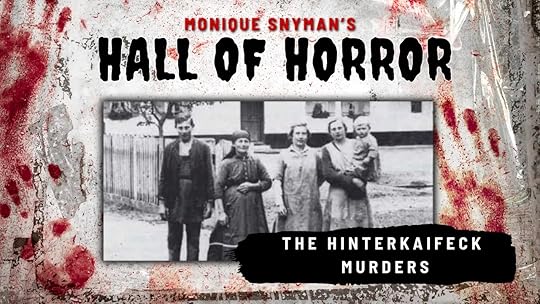
Deep in the Bavarian countryside, in late March of 1922, something terrible happened. It was something so brutal, so inexplicable, it still haunts true crime circles today. On a lonely farmstead known as Hinterkaifeck, six people were murdered with a mattock, a type of pickaxe used for farming. But this wasnât just another rural crime. It was a massacre ⦠a deliberate, quiet, and deeply unsettling massacre that will go down in history.
Andreas and Cäzilia Gruber, their widowed daughter Viktoria, her two children, and the familyâs newly hired maid, Maria Baumgartner, were all slaughtered, most of them being lured into the barn and killed one by one. From the look of things, whoever did it knew the place well. And hereâs where the story gets even more bizarre: the killer stayed after the murders. Eating their food. Sleeping in their beds. Feeding the livestock. Lighting fires. Leaving the bodies hidden in hay.
There were footprints in the snow leading to the house, but there was no sign of footsteps leaving (Hadleigh). The murder weapon came from the property. The dog was alive. The cows were fed. This wasnât random. It was personal. But a century later, we still donât know who did it or why.
An Unnerving Puzzle, Even by Todayâs StandardsWhen neighbors noticed the family hadnât been seen for days, they went to check in. What they found, however, shook the village of Gröbern to its core. Four bodies â Andreas, Cäzilia, Viktoria, and young Cäzilia â were discovered stacked in the barn. The maid and the toddler were murdered inside the home (Serena, 2023).
This wasnât just a killing spree, though. It was methodical. The younger Cäzilia, who was just seven years old, appeared to have survived her initial injuries and pulled out chunks of her own hair in agony before dying (Crime and Conspiracy). And yet, despite the brutality, the house itself showed little sign of struggle or looting. Money and valuables were left untouched.
Was this the first recorded instance of phrogging â the unsettling phenomenon where someone secretly lives inside another personâs home without their knowledge? In the weeks leading up to the murders, the Grubers heard footsteps in the attic, found a set of keys missing, and noticed unfamiliar tracks in the snow. After the killings, someone lingered on the property, tending livestock and even eating meals. Though the term phrogging is modern, the eerie hallmarks were all present in Hinterkaifeck, raising the disturbing possibility that the killer had been living among them all along.
And then thereâs the Gruber family history. Andreas and Viktoria had been convicted of incest years earlier, a fact that branded them in the eyes of the villagers (James and James, 2017). Viktoria had reportedly been involved with several men, including Lorenz Schlittenbauer, a neighbor who once claimed paternity of her son Josef. When he helped discover the bodies, Schlittenbauer had a key, acted oddly calm, and even moved bodies around, allegedly to find his âson.â Suspicious? Absolutely. But it would not be enough to arrest him.
Some theorists point fingers at Schlittenbauer, suggesting jealousy, rage, or shame as motives (Eastern Herald, 2023). Others look beyond Germany.
Could It Have Been a Serial Killer?In The Man from the Train, Bill James and Rachel McCarthy James argue that Hinterkaifeck fits a larger pattern. They suggest an American serial killer named Paul Mueller, who was responsible for axe murders in the U.S., may have made his way to Europe (James and James, 2017). The killerâs M.O. â slaughtering entire families, using tools from their property, often during moonless nights â is nearly identical.
While that theory is fascinating, itâs still speculative. And truth be told, everything about this case is speculation. No fingerprints. No definitive witnesses. No confession. Even the crime scene was compromised: neighbors, priests, and police trampled through it long before a formal investigation began (Schlosser, 2012).
In 2007, German police academy students attempted to re-examine the case using modern profiling. Their conclusion? The killer likely came from within the local community and was familiar with the farm â possibly even a family member or close acquaintance (Mental Floss). But without surviving suspects or clean evidence, thereâs been no resolution.
One Hundred Years Later, Still No AnswersLocals refused to go near the Hinterkaifeck farmhouse, branding it as being cursed, and in 1923, it was demolished. A small shrine now marks the land where it once stood, but the case has never really faded. Itâs kept alive through books, podcasts, YouTube documentaries, and conspiracy blogs that revisit the same theories, again and again, hoping for a new clue, a missing link.
My theory is: What if the Grubers were already dead before the supposed âkillerâ ever arrived? What if the murders werenât a violent act, but the result of something far more insidious â a psychological breakdown within the family? Andreas Gruberâs abusive behavior and his alleged incest with his daughter Viktoria suggest that the household was already on the edge of collapse. So, what if Viktoria, in a desperate act of self-preservation or madness, killed her parents and children before she took her own life? The person who arrived later, tending to the animals and feeding themselves, might not have been the killer at all. It could have just been an innocent farmhand who discovered the aftermath and tried to cover it up, perhaps out of guilt or fear. In this dark analysis Iâve posited, the true horror of Hinterkaifeck wasnât the bloodshed per se (although, I do think it would have been a frightening sight to see), but rather the silence of a family unraveling from within.
In an age of endless true crime content, this one still chills. What was the motive? Why are there no footprints moving away from the house? Was the killer truly local? The truth is, weâll probably never know who killed the Grubers. Itâs the kind of story that gnaws at the imagination because it defies all logic. Someone waited, watched, and struck with precision. And then … that someone vanished into silence.
BibliographyÂCrime and Conspiracy. The Hinterkaifeck Murders: Unraveling Germany’s Chilling Mystery. [online] Available at: https://crimeandconspiracy.com/the-hinterkaifeck-murders/ [Accessed 5 May 2025].
Eastern Herald, 2023. Hinterkaifeck Murders: The Unsolved Mystery That Haunts Germany. [online] 14 Jun. Available at: https://easternherald.com/2023/06/14/hinterkaifeck-murders-mystery-rural-tragedy/ [Accessed 8 May 2025].
Hadleigh, G. The Hinterkaifeck Mystery. [online] Available at: https://www.guyhadleigh.com/blog/the-hinterkaifeck-mystery [Accessed 4 May 2025].
Hinterkaifeck.ch. Books â Hinterkaifeck â Mordfall gelöst. [online] Available at: https://www.hinterkaifeck.ch/en/books/ [Accessed 8 May 2025].
James, B. and James, R., 2017. The Man from the Train: The Solving of a Century-Old Serial Killer Mystery. New York: Scribner.
Mental Floss. The Chilling Story of the Hinterkaifeck Killings, Germanyâs Most Famous Unsolved Crime. [online] Available at: https://www.mentalfloss.com/article/502044/chilling-story-hinterkaifeck-killings-germanys-most-famous-unsolved-crime [Accessed 6 May 2025].
Serena, K., 2023. Hinterkaifeck Murders: The Unsolved German Massacre. [online] All Thatâs Interesting, 3 Aug. Available at: https://allthatsinteresting.com/hinterkaifeck-murders [Accessed 4 May 2025].
If you liked this instalment of Monique Snymanâs Hall of Horror, make sure to subscribe to her newsletter so you donât miss a single post!
May 29, 2025
“Words For My Comrades” Unmasks the Capitalist Machine That Betrayed Tupac
In Words for My Comrades: A Political History of Tupac Shakur, Dean Van Nguyen tears the gloss off hip-hopâs commercial veneer and exhumes the revolutionary fire buried beneath it â a fire that still burns with the legacy Tupac Amaru Shakur has left. This is no sanitized celebration of a multi-platinum rapper or a crime-saga retelling of East Coast vs. West. Instead, Van Nguyen restores Tupac to his rightful place as both a cultural icon and the heir to the radical Black tradition of the Panthers, a vessel through which revolution rapped, rhymed, and raged.
Framing Tupac through the ideological lineage of the Black Panther Party (his mother, Afeni Shakur, being one of its most prominent members), the book illustrates how his lyrics, especially lines like âwords for my comrades,â werenât poetic flairs but political declarations. His music was not about the glamor of thug life but rather about the systemic violence that made âthuggingâ a survival mechanism.
But what happens when radicalism meets the machine? Words for My Comrades is unafraid to wrestle with that uneasy contradiction.
Table of Contents
ToggleFrom Soapboxes to SoundbitesBiggie, the American Dream, and the Tragedy of CompromiseLegacy or Illusion? Hip-Hop’s Forked PathIn Conclusion â¦About Dean van Nguyen:
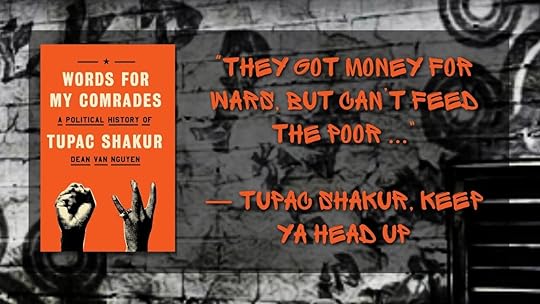
One of Van Nguyenâs sharpest insights is how hip-hopâs political potential was gradually neutralized by capital. While early emcees used verses to mirror articles in The Black Panther newspaper, by the late â90s, lyrics morphed into brand manifestos. N.W.A. may have once declared it wasn’t about a salary, but by the time Puff Daddy a.k.a. Sean Combs took the mic, it was all about the Benjamins â literally.
Van Nguyen dissects this transformation with precision. He traces how figures like Puffy helped shift the genreâs ethos from resistance to excess. Bad Boy Records became a temple of material worship, where the spoils of capitalism â luxury brands like Versace, Bentleys, Cristal â weren’t just flexes but philosophical frameworks. Tracks like “Can’t Nobody Hold Me Down“ and “Mo Money Mo Problems“ were gospel ⦠And in retrospect, they laid the groundwork for hip-hopâs next generation of moguls, from Jay-Z to Travis Scott.
The recent trial of Sean âDiddyâ Combs, who was once the polished face of hip-hopâs billion-dollar ambitions, casts a long, chilling shadow over this narrative. With multiple allegations of abuse, coercion, and violence surfacing, Van Nguyenâs book feels eerily prescient. It reminds us that unchecked power, especially when cloaked in affluence and charisma, often reflects the very systems radical artists like Tupac once tried to dismantle.
Biggie, the American Dream, and the Tragedy of CompromiseWhile Tupac stood as hip-hopâs rebel prophet, Biggie Smalls (The Notorious B.I.G.) became its reluctant poster child for the American Dream. Van Nguyen draws an important parallel here: both men were poets of pain and poverty, but their responses to systemic oppression diverged dramatically. Tupacâs answer was revolution. Biggieâs? Rap his way into legitimacy, first on Ready to Die, then through collaborations with Puffy that embraced the spoils of success.
Their friendship, tragically fractured, Â was symbolic of a larger philosophical rupture within the culture. Words for My Comrades doesnât play up the tabloid drama. Instead, it critiques how the music industry commodified their beef, how the spectacle was fed to hungry consumers, and how even the diss track “Hit âEm Up” became a product in the war for ratings and revenue.
Afeni Shakurâs suspicion â that the infamous rivalry mirrored COINTELPRO tactics meant to pit Black revolutionaries against each other â feels less like paranoia and more like prophecy. Itâs hard to unsee the parallels, especially in a world where the Diddy-Trial leaves readers speechless as the power dynamics within the industry come under intense scrutiny.
Legacy or Illusion? Hip-Hop’s Forked PathJay-Z’s billion-dollar ascent, which is fueled by Roc Nation, champagne lines, and real estate, stands as a potent contrast to Tupacâs unfulfilled political vision. Van Nguyen doesnât fault Jay-Z, but he does position him as emblematic of a hip-hop that has assimilated rather than agitated. American Gangster, Jay-Zâs ode to the duality of drug dealer and mogul, functions less as a critique and more as validation: the system works, if youâre savvy enough to beat it at its own game.
But Van Nguyenâs core argument is that Tupac never tried to beat the system. Tupac wanted to burn it down! And thatâs precisely why his message still matters. In an age where protest is aestheticized and activism is monetized, Words for My Comrades reclaims Tupacâs voice from the clutches of nostalgia and noise. Itâs a reminder that not every artist wanted to become a mogul. Some wanted to remain dangerous.
In Conclusion â¦Words for My Comrades is a searing, essential corrective to the myth-making machine. It doesnât sanitize Tupac. It doesnât villainize Biggie. And it sure as hell doesnât let the industry off the hook. In the wake of Diddyâs legal fallout, this book arrives like a bulletproof manifesto, reminding us that behind every platinum plaque might be a Pantherâs ghost, still howling for justice.
About Dean van Nguyen: Photo: © Daragh Soden
Photo: © Daragh SodenDean van Nguyen is a music journalist and cultural critic for Pitchfork, The Guardian, Bandcamp Daily, and Jacobin, among others. He is based in Dublin, Ireland.
May 15, 2025
Beware the Wrath of the Inkanyamba
In South Africa, one of the most interesting monsters you���ll ever encounter lives in the sky ��� and when it���s angry, the heavens split open.
The Inkanyamba isn���t just a beast. It���s a force. A massive, serpent-like creature said to live in deep waterfalls near Pietermaritzburg and the Howick Falls in South Africa, its wrath summoned through violent storms, tornadoes, and thunder that shakes the bones. And if you think it’s just a tale told to spook the kiddos, think again. Local legend insists that looking into its eyes can kill you.
This is not your average cryptid. It���s weather, myth, and nightmare rolled into one terrifying entity.
Table of Contents
ToggleBorn of Water, Fed by FuryDeath by Glance, Dread by BeliefThe Horror Potential: Raw, Elemental, UnseenDon���t Look Up. Don���t Look Down. Just Run.
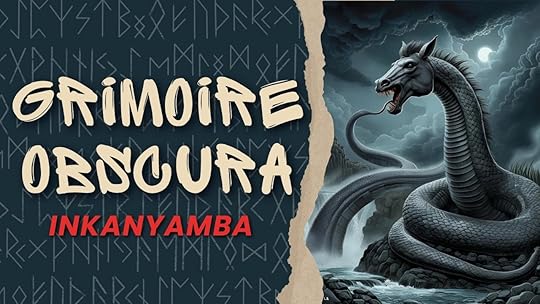
In Zulu and Xhosa oral tradition, the Inkanyamba is described as a massive, eel-like serpent with a horse���s head and bladed fins. It resides in watery places, particularly the Howick Falls, which locals call KwaNogqaza, ���the place of the tall one.��� And tall it is. Some say the Inkanyamba���s body stretches into the clouds, that its movements swirl the air, twisting it into storms. Tornadoes? Well, it���s not weather ��� it���s wrath.
This monster isn���t just dangerous because of its size, though. It���s said to be temperamental and prone to rage when disturbed or disrespected. Locals believe the Inkanyamba’s fury can destroy homes, rip trees from the ground, and bring floods that erase entire villages. Offerings are still made by some traditional healers to calm it, especially during the summer storm season.
Because when the winds start to scream and the water churns violently, it might not be climate change. It might be the Inkanyamba waking up ���
Death by Glance, Dread by BeliefWhat makes the Inkanyamba so compelling isn���t just the monster itself, but rather the way it ties into lived reality. This creature blurs the line between the natural and the supernatural. South Africa does experience freak tornadoes (we had one in Pretoria this year, and it made zero sense!) and powerful storms in regions like KwaZulu-Natal.
It���s not just destruction that follows the creature. It���s dread. Local beliefs warn that direct eye contact with the Inkanyamba can drive a person mad ��� or worse, kill them. And though sightings are rare, those who���ve claimed to see it describe an overwhelming feeling of being watched, as though the sky itself is holding its breath.
If you know what���s good for you, you don���t hunt the Inkanyamba. You pray it doesn���t notice you.
The Horror Potential: Raw, Elemental, UnseenUnlike so many overused monsters, the Inkanyamba is fresh horror fuel. It isn���t just creepy, it���s cosmic. This isn���t a monster you can stab, trap, or outrun. It���s weather given teeth. It taps into primal fears: the storm outside your window, the roar of falling water, the impossible strength of nature when it turns on you.
Visually, it���s a filmmaker���s dream. Imagine a writhing, silver-scaled creature coiling into the clouds as lightning rips across the sky. Imagine hearing thunder, but realizing it���s something breathing instead ��� Imagine a monster that doesn���t stalk you through the woods but descends from the atmosphere like judgment.
And more than that, the Inkanyamba is powerful horror because it doesn���t just threaten individuals ��� it threatens entire communities. It reminds us that the monsters we���ve forgotten still watch from beneath the surface ��� and above the storm.
Don���t Look Up. Don���t Look Down. Just Run.The Inkanyamba doesn���t care about your rules. It doesn���t wait until dark or follow some ancient curse. It lives when and where it wants, bound to wind, water, and rage. And the scariest part? There���s nothing you can do to stop it.
Next time the storm clouds roll in and the winds shift too fast, listen closely. That roar? It might not be thunder. It might be something ancient, angry, and very much awake.
Want another folklore freak to haunt your Friday? Stick around. Grimoire Obscura digs deeper every week ��� because the real monsters aren���t hiding under your bed. They���re waiting in plain sight.
May 13, 2025
Books That Feel Like Listening to True Crime Podcasts at 2AM
There���s a particular breed of thrill-seeker who finds comfort in the macabre. You know the type ��� wide awake while the rest of the world sleeps, earbuds in, diving deep into decades-old cold cases, unreliable narrators, and killers who seem too smart to catch. Me ��� It���s me. I���m that type. It���s the 2AM true crime obsession. The thrill. The dread. The morbid curiosity that keeps you hitting ���next episode��� when you should be going to bed.
These 8 books ��� both fiction and non-fiction ��� replicate that same experience. They’re layered, voice-driven, and built to unspool like your favorite podcast. But like all good true crime, they don���t just tell a story. They ask hard questions, they play with perception, and they���re always two steps ahead of you.
Table of Contents
Toggle8 Killer ReadsWhat Lies in the Woods by Kate Alice MarshallTrue Crime Story by Joseph KnoxKiller Stories by Brin Hodgskiss & Nicole EngelbrechtA Flicker in the Dark by Stacy WillinghamI���ll Be Gone in the Dark by Michelle McNamaraThe Appeal by Janice HallettMy Lovely Wife by Samantha DowningCatch Me a Killer: A Profiler���s True Story by Micki Pistorius
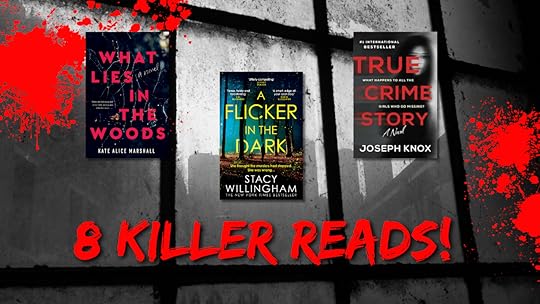
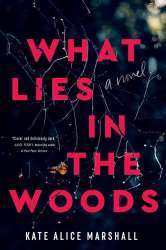 What Lies in the Woods by Kate Alice Marshall
What Lies in the Woods by Kate Alice MarshallThree girls. One lie. And a secret buried for decades.
Naomi and her two best friends survived a brutal attack in the woods when they were eleven. They identified the man responsible and became local legends as a result. But now, years later, that story is starting to unravel. Marshall spins a sharp, atmospheric thriller that hinges on memory, trauma, and the power of the stories we tell ourselves to survive. Perfect for fans of cold cases, unreliable survivors, and the haunting realization that no one tells the whole truth ��� not even victims.
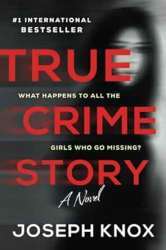 True Crime Story by Joseph Knox
True Crime Story by Joseph KnoxA missing university student. A true crime writer who gets too close.
Structured like an investigative podcast transcript, this novel blurs fiction and reality until you���re questioning everything. Joseph Knox weaves in real-world commentary and disturbing redactions to craft a story so convincingly meta, you���ll be Googling names just to be sure it���s not real. It’s unsettling, brilliant, and more than a little unhinged. This is the kind of story that makes you feel complicit just for reading.
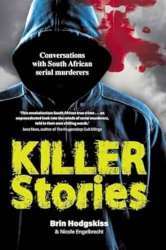 Killer Stories by Brin Hodgskiss & Nicole Engelbrecht
Killer Stories by Brin Hodgskiss & Nicole EngelbrechtReal killers. Real confessions. Real nightmares.
Forget fiction. This is the stuff your favorite podcasts only scratch the surface of. Psychologist Brin Hodgskiss sat face-to-face with South Africa���s most dangerous serial killers, capturing their words, their delusions, and their terrifying rationalizations. Years later, true crime podcaster Nicole Engelbrecht unearthed his recordings, and together they created a chilling, psychologically rich book that goes beyond the headlines. What emerges is a study in narrative psychology, human depravity, and the disturbing similarities between their stories ��� and ours.
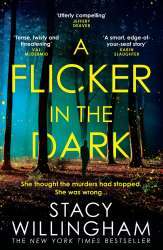 A Flicker in the Dark by Stacy Willingham
A Flicker in the Dark by Stacy WillinghamSmall towns don’t forget their monsters.
Chloe Davis has spent her life outrunning her past, specifically, the fact that her father confessed to murdering six teenage girls when she was just twelve. Now a psychologist, she���s built a carefully controlled life. But when local girls begin disappearing again, the past claws its way back. Willingham creates a Southern gothic atmosphere pulsing with dread, wrapped around a protagonist who may or may not trust herself.
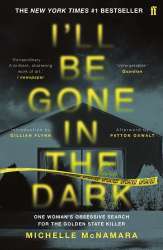 I���ll Be Gone in the Dark by Michelle McNamara
I���ll Be Gone in the Dark by Michelle McNamaraThe real thing is more terrifying than fiction.
Part memoir, part investigation, this book documents Michelle McNamara���s obsessive hunt for the Golden State Killer, a man who eluded authorities for decades. What sets this apart isn���t just the case, but rather the humanity. McNamara���s writing is intimate, insightful, and heartbreaking, capturing the thrill of the chase and the psychological toll it takes. A must-read for anyone who wants to understand the mind of a sleuth, and the monster she’s chasing.
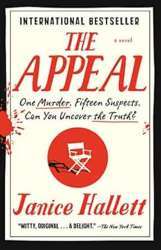 The Appeal by Janice Hallett
The Appeal by Janice HallettMurder hidden between the lines.
Told entirely through emails, texts, and police notes, this novel task the reader with unraveling the mystery behind a death in a small-town drama group. But as the mundane correspondence piles up, something darker starts to emerge. Hallett doesn���t just play with form, she turns the reader into the investigator. It���s as voyeuristic and addictive as eavesdropping on a case file nobody wanted you to see.
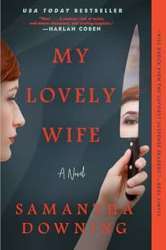 My Lovely Wife by Samantha Downing
My Lovely Wife by Samantha DowningSuburbia has never been this bloodthirsty ���
A married couple bond over the thrill of killing, but this isn’t just a dark fantasy. It’s a chilling examination of appearances, complicity, and the thin veneer of civility. Downing plays with the concept of the ���perfect marriage��� and twists it into something cold, calculated, and disturbingly seductive. You’ll read this one with morbid glee, questioning how far you’d go for love, and whether you’d even see it coming.
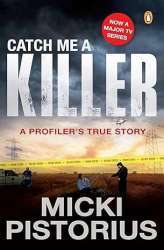 Catch Me a Killer: A Profiler���s True Story by Micki Pistorius
Catch Me a Killer: A Profiler���s True Story by Micki PistoriusShe hunted monsters. Then wrote about them.
As South Africa���s first criminal profiler, Micki Pistorius walked into the minds of killers and emerged with insight most of us hope never to need. From the Station Strangler to the Phoenix Cane Killer, these real-life cases are told with clinical precision and eerie clarity. But this isn���t just about murderers, it���s about the people who catch them, and the darkness they carry away. If Mindhunter is your comfort binge, this is your next obsession, believe me. You can read my review here.
Can���t stop. Won���t sleep. Still pressing play ���
Check out some other Book Lists, and make sure to subscribe to Monique���s newsletter so you don���t miss a single post!
May 12, 2025
Book Review: The Manor of Dreams by Christina Li Exposes Family Secrets …
Christina Li���s The Manor of Dreams is the kind of novel that will haunt you in ways you didn���t think possible. On the surface, it’s about a former Hollywood starlet���s death and a mysterious inheritance that throws two families into uneasy proximity. The story digs deep into cultural identity, ambition, resentment, generational grief, and the quiet terror of what gets passed down without anyone ever speaking it out loud.
When the former starlet���s will reveals an unexpected heir, however, the house doesn���t just become contested property, but rather contested memory. Each character arrives believing they know what they���re owed, emotionally and materially. But the house has its own ideas ��� and so does Li.
Table of Contents
ToggleThe Ghosts We Carry, The Ones We BecomeInheritance As Curse, Ambition As BaitThe Ache Of The UnsaidIn The End ���About Christina Li:
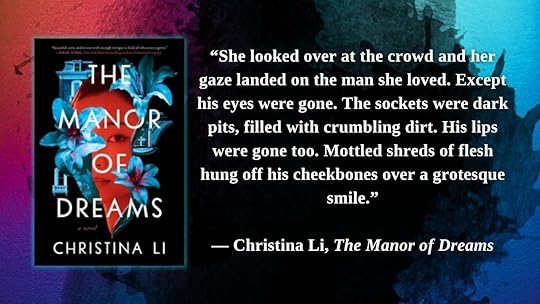
The brilliance of The Manor of Dreams lies in how it handles perspective. The narrative moves fluidly between characters ��� mothers and daughters from both sides of the inheritance divide ��� which offers layered glimpses into the baggage they���ve brought with them. Some of that baggage is cultural, some of it is personal. All of it is heavy, though.
This isn���t a horror novel in the traditional sense, but make no mistake: The Manor of Dreams is deeply unsettling. It���s the kind of story where the dread doesn���t come from what jumps out, but from what seeps in. The quiet rot it exposes in the foundations of family runs deep, festering, until even the walls seem heavy with memory. The house doesn���t just creak or groan; it reacts. Its spaces don���t feel haunted so much as saturated, steeped in the weight of what���s been done and left unsaid. Rooms remember. Gardens respond. And whether or not you believe in ghosts, Li makes it clear that trauma has a way of lingering.
The characters come undone, shedding the roles they���ve been forced into ��� dutiful daughter, abandoned child, silent witness ��� and questioning what���s left underneath. Each chapter adds another shade to the story, another revelation that complicates what we think we know. But it���s never melodramatic. Li doesn���t deal in theatrics. She deals in truth, and how much it costs to unearth it.
Inheritance As Curse, Ambition As BaitThe Manor of Dreams asks: What are people willing to endure, erase, or become in order to claim what they think is rightfully theirs? The house becomes a mirror, reflecting the quiet hungers of everyone who enters. Some want recognition. Others want safety, or closure, or absolution. Most want something they can’t even name.
And Li is smart enough not to make that desire simple. She doesn���t divide her characters into good and bad. Everyone here is flawed, but that complexity is where the novel finds its power. Even the ominous house, wild, almost sentient, feels like a character shaped by the ambition and loss of the people who lived within its walls.
There���s also something deeply rewarding about how the novel engages with identity, particularly through its intergenerational lens. The tensions between immigrant and American-born experiences, the class differences between the two families, and the unspoken realities of queerness and female ambition ��� all of these threads are pulled taut, never forced, always deliberate.
The Ache Of The UnsaidWhat elevates this novel beyond its gothic bones is its emotional intelligence. It���s not afraid to sit in the murky places. Li doesn���t offer tidy resolutions. She���s not interested in vindication or punishment. She���s interested in what happens when people are finally forced to confront the stories they���ve told themselves their entire lives.
There are moments of beauty here, though. Quiet, aching, often uncomfortable. A glance between strangers who share a history they can���t name. A conversation that veers just close enough to the truth to wound. A garden that seems to know more than it should. Every detail feels intentional, every interaction loaded with unspoken context. It���s emotionally dense without ever feeling overwrought.
And even when the house slips into the surreal, it never loses its emotional grounding. The supernatural elements aren���t spectacle; they���re metaphor, manifestation, memory … They exist to underscore the emotional and psychological weight of the narrative, not distract from it.
In The End ���This isn���t a breezy family drama or a conventional ghost story. The Manor of Dreams pushes into murkier territory, where unease lingers in the silences and the emotional weight never quite lets up. It invites you to lean in closer, to notice what���s left unsaid, and to reckon with how the legacies we inherit, both spoken and unspoken, can quietly reshape who we are. It’s scary and good. A must-read!
About Christina Li: Christina Li is the award-winning author of children���s books Clues to the Universe, which was a Washington Post summer book club pick, and Ruby Lost and Found, which was an NPR and New York Public Library Best Book of the Year and recognized for the Asian Pacific American Librarians��� Award for Best Children���s Literature. She is also the author of the YA title True Love and Other Impossible Odds, as well as a forthcoming fiction debut, The Manor of Dreams (Avid Reader Press), which has been listed as one of TIME Magazine���s most anticipated novels of 2025.
Christina Li is the award-winning author of children���s books Clues to the Universe, which was a Washington Post summer book club pick, and Ruby Lost and Found, which was an NPR and New York Public Library Best Book of the Year and recognized for the Asian Pacific American Librarians��� Award for Best Children���s Literature. She is also the author of the YA title True Love and Other Impossible Odds, as well as a forthcoming fiction debut, The Manor of Dreams (Avid Reader Press), which has been listed as one of TIME Magazine���s most anticipated novels of 2025.
She loves to daydream about characters and drink too much jasmine green tea. She grew up in the Midwest and California but now calls New York home.




